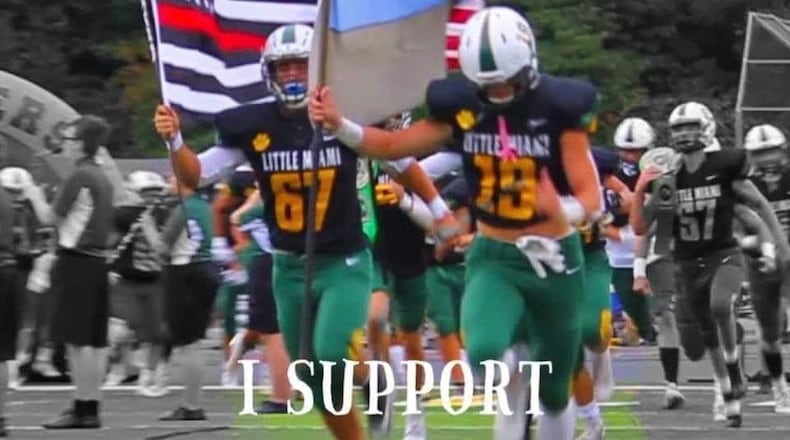Their decision to defy school rules eventually saw them suspended from school, then reinstated, then last week standing next to President Donald Trump at a political rally in Toledo where they were cheered by thousands.
The move came just weeks after a Lakota West High School student’s painted parking space commemorating police was vandalized.
Toss in a global coronavirus pandemic’s mask orders and one of the most contentious presidential campaigns in years and the long-simmering issue of students' free expression rights is in the spotlight again.
Law experts and local school officials say the tensions over what’s allowed in schools has long been a constant part of the modern school environment.
“The intensity of the stories is due to the polarization for the country,” said University of Cincinnati law professor Ronna Greff Schneider, who specializes in school law and is co-editor of the Education Law Stories.
The record of court decisions forming the evolution of American legal rights for students long ago established “students don’t give up their rights when they walk through the school doors,” she said.
Schools, however, have their own legal precedence for maintaining a peaceful place to perform their educational mission.
In other words, said Schneider, “student rights in the classroom are not the same as adult rights on Fountain Square” in downtown Cincinnati.
Student rights corralled by “forecast of disruption”
Each of Ohio’s 613 public school systems are autonomous in many ways including their locally created student codes of conduct developed over years.
The degree to how local school districts can restrict political-oriented signs, clothing and actions has in recent years been shaped by a general legal philosophy as determined by various court decisions, said Schneider.
The defining legal focus now widely applied in schools, she said, is whether school officials can make a “forecast of disruption” stemming from what a student is expressing.
Context is key, she said.
“Sometimes schools ban the display of the Confederate flag based on the history at that school and sometimes because of the racial relations at the time,” she said.
For schools, said Schneider, “there is a right in these contentious times to make this forecast of disruption.”
Vigilance is important, said area school officials.
If a school is always reactive rather than proactive on making sure students understand what is appropriate, then the school is already losing when a controversy erupts, they said.
“The first time that people should be trying to talk about a controversial issue should not be when controversy has exploded,” said Madison Schools Superintendent Lisa Tuttle-Huff. “School districts will inevitably face challenges based on different beliefs of communities and families. We must respect the multiple perspectives that members of the school community — faculty and staff, students, parents, school partners — may have about an issue.
“One helpful avenue is to show support for students' civic engagement in a positive manner. Showing support does not mean that students can be disrespectful to others or be disobedient in the school environment. To help students understand what positive civic engagement looks like, it is the school’s responsibility to encourage conversations about controversial issues throughout the year in a positive manner."
But it’s a constant balancing act, she said.
“At the same time, it is also vital that we protect students from being bullied because of their beliefs.”
In Warren County’s largest school system, measuring out the right amount of free expression allowed is also important in providing non-classroom instruction for students to better understand America’s concept of the free marketplace of competing ideas.
“Our schools are reflections of the community we serve, and our educators are often grappling with how they support students who are finding their voices and advocating for causes that are deeply personal and meaningful for them,” said Tracey Carson, spokeswoman for the 10,400-student Mason Schools.
“It is our duty to ensure that all the learners in our classrooms feel that they belong, and that their story matters,” said Carson.
“And our staff recognizes the influence we have, and that’s why it is important we coach students to critically think, versus shaping students' views. Our diverse classrooms can become powerful places where students can learn about each other, and why someone else - with a different life experience - may have a very different view of local, national and global events,” she said.
“We work hard to make sure that our classrooms are safe and brave spaces where students can express themselves respectfully and encourage each other.”
Student expression in the region
Earlier this month two Little Miami High School football players were initially suspended - later instated - for carrying pro-police and firefighter flags onto their home field during pre-game introduction of the team. The two players received national media attention and joined President Donald Trump at his invitation on stage during a Toledo political rally this week.
In August a Lakota West High School student’s parking space -featuring a pro-police painting - was vandalized with Black Lives Matter (BLM) profanity.
In 2018 some area students participated in a National Walk Out event to commemorate the deaths of 17 students who died from gunfire at a Parkland, Florida high school. Some area schools allowed the short protest ceremony - Hamilton, Fairfield and Middletown - but officials in Monroe Schools did not permit student participation.
About the Author

